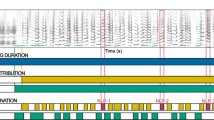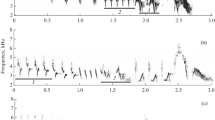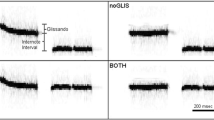Summary
Aims: Further investigation of the “component of throttling back” which functions as a short term inhibition of particular vocal outputs (song-phrases) of birds (Fig. 1).Methods: Blackbirds (Turdus merula) having a clearly organized singing behaviour and living under controlled conditions were exposed to “taped copies” of song phrases of their own repertoire. The experiments consisted of “echo-stimulations”, “continued stimulation” and of combinations of both of these (Fig. 2). Additionally the normal songs of the birds were recorded for control.Results:
-
1.
Under continued stimulations with copies of a particular one of their phrases—here called output “A”—the birds uttered their own outputs A more often than in normal songs but almost as frequently as under echo stimulations with A. During the experiments the releasing effect of the stimuli did not decrease; in other words: there was no afferent adaptation to the stimuli. The echo stimulation with A raised the repetition rate of output A. (Effects of the input-component: Fig. 4.)
-
2.
Auditory stimulations with pattern A changed the rate of output A occurring at the preferred recurrence intervals. However, they did not change the length of this preferred intervals. (Effects of the period component: Fig. 4.)
-
3.
The increase in the repetition rates of output A did not exceed a certain limit (Fig. 3). In correlation with this increase two types of effects were observed: In comparison with normal songs there was first a sharp decline in the ratio of outputs A uttered within a sequential interval of 3 or 4 phrases (short term effect). After a sequential interval A→A of more than 4 phrases there followed a slow recovery (long term effect) of that ratio. The magnitude of both the decline and the recovery were proportional to the initially increased repetition (Fig. 5).
These effects are explained by the “component of throttling back of outputs”: The values of the throttling component have to range between 0 and 1 and interact with the actual values of the other components multiplicatively. Every utterence of an output A results in a reduction of the value of the “throttling component” belonging to this output. The reduction declines “slowly” (Figs. 6, 7).
Similar content being viewed by others
References
Baerends, G. P., Brower, R., Waterbolk, H. T.: Ethological studies onLebistes reticulatus (I. Analysis of the male courtship pattern). Behav.8, 249–334 (1955)
Brémond, J. C.: Recherches sur la sémantique et les éléments vecteurs d'information dans les signaux acoustiques du rouge-gorge (Erithacus rubecula L.). Terre et la Vie2, 109–220 (1968b)
Curio, E., Blaich, R., Rieder, N.: Funktionszusammenhang zwischen einer Handlung und der ihr zugrundeliegenden Erregung als Grundlage der Ethometrie von Schlüsselreizen. Z. vergl. Physiol.62, 301–317 (1969)
Emlen, S. T.: An experimental analysis of the parameters of bird song eliciting species recognition. Behav.41, 130–171 (1972)
Falls, J. B.: Properties of bird song eliciting responses from territorial males. Proc. 13th Intern. Ornithol. Congr.1, 250–271 (1963)
Ficken, M. S., Ficken, R. W.: Effect of number, kind and order of song elements on playback responses of the Golden-winged Warbler. Behav.46, 114–127 (1973)
Heiligenberg, W.: Ursachen für das Auftreten von Instinktbewegungen. Z. vergl. Physiol.47, 334–380 (1963)
Heiligenberg, W.: The effect of external stimuli on the attack readiness of cichlid fish. Z. vergl. Physiol.49, 459–464 (1965)
Hinde, R. A.: Alternative motor patterns in Chaffinch song. Anim. Behav.6, 211–218 (1958)
Konishi, M.: The role of auditory feedback in the control of vocalization in the white-crowned sparrow. Z. Tierpsychol.22, 770–783 (1965)
Lemon, E. R., Chatfield, C.: Organization of song in cardinals. Anim. Behav.19, 1–17 (1971)
Marler, P.: The behaviour of the Chaffinch. Behaviour, Suppl.5, 1–178 (1956)
Nelson, K.: Courtship in the male three spined stickleback. Z. vergl. Physiol.50, 569–597 (1965)
Nottebohm, F.: The role of sensory feedback in the development of avian vocalizations. Proc. XIV. Internat. Ornithol. Congr., 265–280 (1967)
Sevenster, P.: A causal analysis of a displacement activity. Behaviour, Suppl.9, 1–170 (1961)
Sevenster-Bol, A. C. A.: On the causation of drive reduction after a consummatory act. Arch. neerl. Zool.15, 175–236 (1962)
Thimm, F.: Sequentielle und zeitliche Beziehungen im Reviergesang des Gartenrotschwanzes. J. comp. Physiol.84, 311–334 (1973)
Thimm, F., Clausen, A., Todt, D., Wolffgramm, J.: Zeitabhängigkeit von Verhaltensmusterfolgen. J. comp. Physiol.93, 55–84 (1974)
Thompson, W. L.: Singing behavior of the indigo bunting. Z. Tierpsychol.31, 39–59 (1972)
Todt, D.: Zur Steuerung unregelmäßiger Verhaltensabläufe — Ergebnis einer Analyse des Gesangs der Amsel. Kybernetik 968, S. 465–485, Hrsg.: H. Mittelstaedt. München: Verlag Oldenbourg 1968
Todt, D.: Gesangliche Reaktionen der Amsel auf ihren experimentell reproduzierten Eigengesang. Z. vergl. Physiol.66, 294–317 (1970)
Todt, D.: Äquivalente und konvalente gesangliche Reaktionen einer extrem regelmäßig singenden Nachtigall. Z. vergl. Physiol.71, 262–285 (1971)
Todt, D.: Biologisch-kybernetische Analyse der Komposition des Gesanges verschiedener Vögel. In: Lueken, B., Scharf, H. J. (Hrsg.), Nova Acta Leopoldina, N. F. Nr 208, 37 (2), 311–331 (1973)
Todt, D.: Zur Bedeutung der „richtigen“ Syntax auditiver Muster für deren vokale Beantwortung durch Amseln. Z. Naturforsch.29c, 157–160 (1974)
Todt, D., Wolffgramm, J.: Überprüfung von Steuerungsmodellen zur Strophenanwahl der Amsel durch digitale Simulierung. Biol. Cybernetics17, 109–127 (1975)
Wolffgramm, J.: Lautmustersequenzen und periodische Beziehungen im Rollerkanari-Gesang. J. comp. Physiol.85, 65–88 (1973)
Author information
Authors and Affiliations
Additional information
Mit Unterstützung durch den SFB 70 (Hirnforschung und Sinnesphysiologie; Freiburg).
Rights and permissions
About this article
Cite this article
Todt, D. Short term inhibition of outputs occurring in the vocal behaviour of blackbirds (Turdus merula m. L.). J. Comp. Physiol. 98, 289–306 (1975). https://doi.org/10.1007/BF00709802
Received:
Issue Date:
DOI: https://doi.org/10.1007/BF00709802




